| Author | Affiliation |
|---|---|
| Dale Birenbaum, MD | University of Central Florida School of Medicine, Florida Hospital Emergency Medicine Residency Program, Orlando, FL |
| Laura W. Bancroft, MD | University of Central Florida School of Medicine, Florida Hospital Deptartment of Radiology, Orlando, FL |
| Gary J. Felsberg, MD | University of Central Florida School of Medicine, Florida Hospital Deptartment of Radiology, Orlando, FL |
ABSTRACT
Imaging in the acute setting of suspected stroke is an important topic to all emergency physicians, neurologists, neurosurgeons and neuroradiologist. When it comes to imaging, the American College of Radiology (ACR) continually updates its guidelines for imaging pathways through the ACR Appropriateness Criteria.1,2 This article is a general review of the imaging modalities currently used to assess and help guide the treatment of strokes.
NONCONTRAST COMPUTED TOMOGRAPHY
Rapid evaluation of acute stroke patients will increase as the population ages and acute therapies expand. One significant aspect in the evaluation of acute ischemic stroke patients is imaging. Currently in the United States, noncontrast computed tomography (CT) remains the primary imaging modality for the initial evaluation of patients with suspected stroke (Figure 1).1,2
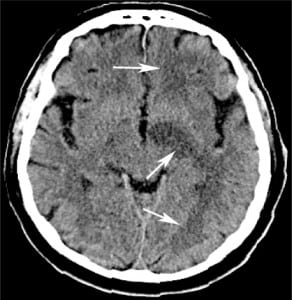
Three main stages are used to describe the CT manifestations of stroke: acute (less than 24 hours), subacute (24 hours to 5 days) and chronic (weeks).3 Acute stroke represents cytotoxic edema, and the changes can be subtle but are significant. They are also termed “early ischemic changes “and were formerly termed “hyper-acute”. It is intracellular edema and causes loss of the normal gray matter/white matter interface (differentiation) and effacement of the cortical sulci. A thrombus in the proximal middle cerebral artery (MCA) is sometimes seen in the acute phase and appears as hyperattenuation. A subacute stroke represents vasogenic edema, with greater mass effect, hypoattenuation and well-defined margins. Mass effect and risk of herniation is greatest at this stage. Chronic strokes have loss of brain tissue and are hypoattenuating.
A noncontrast head CT may identify the early signs of stroke, but most importantly will exclude intracerebral hemorrhage and lesions that might mimic acute ischemic stroke such as tumor or intracerebral hemorrhage. Noncontrast CT is also used in the evaluation of acute intracranial hemorrhage as it produces good contrast between the high attenuating (“bright”) clot and the low attenuating (“dark”) cerebrospinal fluid (CSF) [Figures 2, ,3,3, ,44].4 This tool’s availability and speed make it very useful in the initial evaluation of suspected stroke patients.
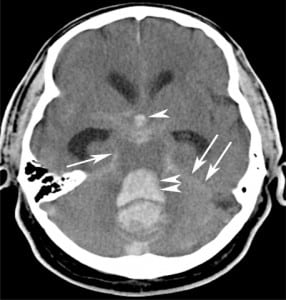
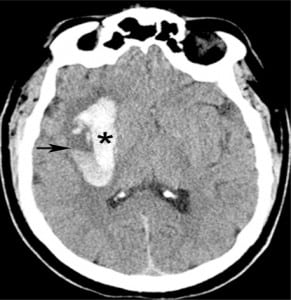
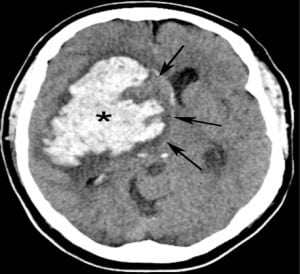
COMPUTED TOMOGRAPHY ANGIOGRAM
Newer generation multi-slice CT scanners are becoming more readily available.
CT angiogram (CTA) is a minimally invasive study that requires a time optimized rapid injection of intravenous contrast and thin-section helical CT images are obtained in the arterial phase.
Software allows thin-section axial CT images to be reformatted in any plane enabling a more complete evaluation of vessels. Three-dimensional reformations of contrast-enhanced CT angiograms provide clear images of cerebral blood vessels. Imaging of the entire intra and extra cranial circulation beginning at the aortic arch and continuing through the Circle of Willis can frequently be performed within 60 seconds. (Figure 5).5–7
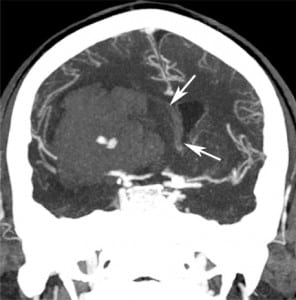
The identification of areas of stenosis or occlusion of vessels allows for rapid and accurate diagnoses and decisions in the clinical arena. CT angiograms that identify occluded blood vessels in the brain assist the neurologist and emergency physician in treatment decisions.
When the CT angiogram reveals an occlusion of a major cerebral blood vessel within the three hour time limit, then the decision to administer intravenous tissue plasminogen activator (TPA, specifically alteplase) can be made with more confidence as the cause of the stroke is more accurately identified. Intra-arterial administration of thrombolytics or mechanical clot removal using catheter angiography might be beneficial in patients presenting later than three hours if a large and accessible thrombus is identified and it becomes the decision of the skilled interventional neuroradiologist or neurosurgeon to consider these patients for experimental therapy. The identification of extracranial carotid arterial disease on the CTA and the visualization of the aortic arch might provide the cause of an ischemic event. For example, when a carotid dissection is identified on the CTA, then more aggressive mechanical thrombolytic therapy would not be indicated.7
In addition to identifying stenotic and occluded blood vessels the CTA can provide images of aneurysms (Figures 6 and and7)7) and other vascular abnormalities such as arterio-venous malformation (AVM) and their feeding arteries and veins (Figure 8).4 Rotation of these images can also assist stroke neurologist, interventional neuroradiologist and surgeons in planning operations and procedures.
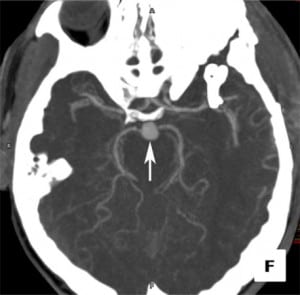
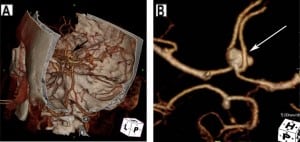
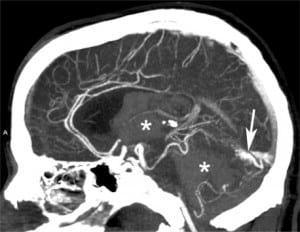
Many comprehensive stroke centers are beginning to use this technique in all acute stroke patients. The most important limitations to contrast enhanced CT are prior allergic reactions and patients with underlying renal insufficiency.
COMPUTED TOMOGRAPHY PERFUSION
CT perfusion is more widely available than magnetic resonance imaging (MRI) and can be performed quickly on any standard helical CT scanner right after unenhanced CT. During CT perfusion a rapid intravenous infusion of contrast is administered and sections of the brain are repeatedly imaged. Based on the total amount and speed that blood flows to different vascular territories of the brain this technique can assist in identifying a stroke and potential areas of reversible and salvageable brain tissue in the ischemic penumbra.7
The cerebral blood flow (CBF) is equal to the cerebral blood volume (CBV) divided by the mean transit time (MTT). The MTT is the time difference between the arterial inflow and venous outflow.7–10 MTT is the most sensitive measure used to evaluate for flow abnormalities. It is prolonged in conditions such as hypotension along with occluded and stenotic blood vessels. Time –to –peak (TTP) is sometimes used in place of MTT.
During a stroke, the area of the brain undergoing infarction has both decreased CBF and CBV.3Decreased total CBV is the most specific indicator for an area actually undergoing irreversible ischemia or infarct and is non salvageable.
Areas of the brain that are at risk for injury known as the ischemic penumbra show decreased CBF with normal to increased CBV. This potentially salvageable area of the brain must have an intact cerebral autoregulation system to maintain homeostasis. Cerebral autoregulation causes the dilation of the collateral blood vessels and increases the CBV to the areas of the brain that are compromised by decreased CBF (Figure 9).3 As an example, tissue distal to the occluded vessel (usually the MCA), receives collateral flow from adjacent non occluded vessels (ACA and PCA). Perfusion to these tissues is characterized by delay in arrival of the contrast bolus but preservation of the total amount of contrast reaching the brain tissue. CT perfusion imaging can identify the penumbra, and it has been used in case reports and studies to guide the treatment of patients in which there is an unknown time of stroke onset, awakening stroke or when the patient cannot communicate the time of onset due to aphasia. These patients may still benefit by intravenous, intra-arterial or mechanical reperfusion. The technique can also be used to evaluate for secondary vasospasm in patients who have sustained subarachnoid hemorrhage.4
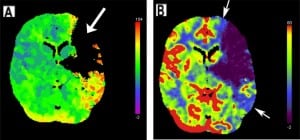
CT perfusion does have some limitations for it requires multi-detector CT (MDCT) and a special software package which needs to be set up by trained technologist. The software package that is used for CT perfusion analyzes the images obtained and color coded maps representing many levels of the brain are produced to help differentiate the potential cause of the flow abnormalities. Current CT perfusion technology is limited to two slices through the brain. (Higher row MDCT= 64 slice or greater) will be able to image a greater volume of brain tissue. CT perfusion produces a greater amount of radiation exposure to the levels being imaged- roughly 40 CT slices through the same level of the cranium. If the perfusion CT software and equipment is not set up correctly, massive radiation doses may result.
MAGNETIC RESONANCE IMAGING
Conventional brain MRI studies can take up to one hour to complete. The study is not very good at detecting cytotoxic or intracellular edema that is seen in the acute or less than 24 hour phase of stroke. Standard MRI images (T1 and T2) are good at detecting vasogenic edema that is present in the subacute phase of stroke and is seen at greater than 24 hours to several days. Fast spin echo T2- weighted sequences can clearly demonstrate areas of edema not visible on the CT and can help identify a subacute stroke as seen in (Figure 10). Fluid attenuated inversion recovery (FLAIR) sequences are designed to suppress signal from the CSF so that it will appear dark. FLAIR images provide good conspicuity of acute subarachnoid hemorrhage, as compared to conventional T-1 and T-2 weighted images and are useful in the initial evaluation of the acute stroke patient suspected of having a subarachnoid hemorrhage. Subarachnoid hemorrhage appears bright on FLAIR images and so becomes readily apparent.
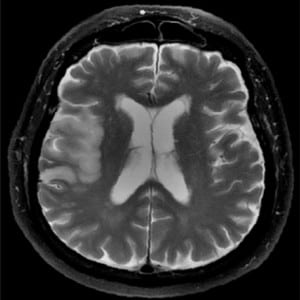
The gradient recalled echo (GRE) sequence is also useful for the detection of blood products. Hypointensity due to paramagnetic effect of the hemosiderin, otherwise known as “blooming,” affects the magnetic field and decreases the signal. Therefore blood appears “black” on GRE images (Figure 11).11
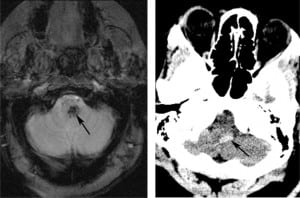
MAGNETIC RESONANCE DIFFUSION
MR diffusion is a technique that is having a dramatic affect on the approach and management of acute ischemic stroke patients.12–14 MR diffusion is diffusion weighted images (DWI) and can be obtained within 10 minutes at some centers and dramatically alter care, so the clinical determination of ischemic stroke can be confirmed quickly. DWI is used to detect early ischemic changes (acute stroke; early ischemic change; cytotoxic edema) with greater conspicuity than standard MRI. MRI with diffusion is quickly becoming the gold standard in acute stroke imaging. Once a hemorrhagic stroke has been excluded by CT, MR diffusion improves stroke detection from 50% to more than 95%.3–4,14 Diffusion MR noninvasively detects ischemic changes within minutes of stroke onset.
It is the ability to quantify the motion of water molecules that makes the process of diffusion weighted MRI possible. Normal uninjured neuronal cells allow for the equal movement of water between healthy cells. During an acute ischemic stroke cytotoxic intracellular injury to the neuronal cell occurs and intracellular water accumulates in the injured cells as the cells ability to allow for the water to diffuse out is decreased. The difference in the water content and the diffusion of water between injured and uninjured cells can be measured and allows for the identification of ischemic cells on diffusion MRI images. These areas of damage appear bright on MR diffusion images.7,14
In order to help identify areas of ischemia, apparent diffusion coefficient (ADC) maps are used and areas that are bright on diffusion and dark on ADC are consistent with acute infarct (Figure 12). It is necessary to use ADC maps because some areas of high signal such as vasogenic edema can appear bright on the initial diffusion image signaling. This is because the diffusion sequence is T-2 based and this “shine through” can cause some bright signals, but these areas of high signal that are not secondary to acute infarct are easily identified on the ADC maps and allow for an accurate initial diagnosis. Over time, the appearance of the diffusion and ADC abnormalities will reverse as the stroke moves into a subacute phase (more than 24 hours to 5 days).4,7 The specific injury patterns that are identified on MRI diffusion help the skilled neuroradiologist to date the time of onset, progression and resolution of strokes.
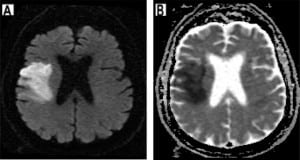
MR diffusion imaging allows clinicians who are evaluating challenging patients with neurological deficits to differentiate between those who actually have an acute ischemic event versus those who do not. It can therefore help differentiate a stroke from other stroke mimics such as a hemiplegic migraine headache, Todd’s paralysis (seizure) and peripheral or cranial nerve disorders.
MAGNETIC RESONANCE IMAGING PERFUSION
Pefusion imaging of the entire brain is one of the main advantages of perfusion-MR (perfusion weighted imaging=PWI), in which MMT or TTP perfusion maps are generated for the entire brain.3Like CT perfusion, it can identify the ischemic penumbra. The ischemic penumbra is the difference between the DWI defect (cytotoxic edema-irreversible ischemia- the ischemic core) and the perfusion defect-analogous to MTT or TTP). The penumbra is the DWI-PWI mismatch. The accurate identification of this ischemic penumbra will help guide future ischemic stroke therapy and potentially aide in extending the time window for treatment.
MAGNETIC RESONANCE ANGIOGRAPHY
Magnetic resonance angiography (MRA) can be performed in combination with brain MRI in the setting of stroke to help guide therapeutic decision making. It can detect high grade atherosclerotic lesions in the neck and head. It is also helpful for detecting less common causes of ischemic stroke such as carotid and vertebral artery dissection, fibromuscular dysplasia, and venous thrombosis. As with other forms of MRI imaging it cannot be used in patients with pacemakers, some metallic implants, allergy to MR contrast agents, and in those with severe claustrophobia.
SONOGRAPHY
Transcranial doppler (TCD) examination of the head and doppler imaging of the carotid vessels are helpful adjunct modalities in the evaluation of acute stroke.15–17 This may be especially useful for patients who are unstable. TCD can be performed for the evaluation of the basal intracranial arteries in patients with acute ischemic stroke who are not eligible for standard imaging techniques, such as CTA or MRA (Figure 13). The arteries best evaluated are those at the base of the brain (MCA, anterior cerebral artery, carotid siphon, vertebral artery, basilar and ophthalmic artery). However, up to 30% of patients are unable to be examined by this technique due to impedance from the temporal bone.15 The primary application of TCD are to detect and quantify intracranial vessel stenosis, occlusion, collateral flow, embolic events, and cerebral vasospasm (particularly after SAH). Carotid Doppler imaging has been proven to be accurate in the assessment of degree of occlusion of the extracranial portions of internal carotid artery.
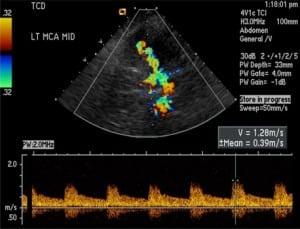
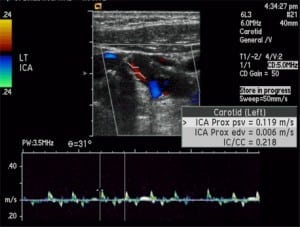
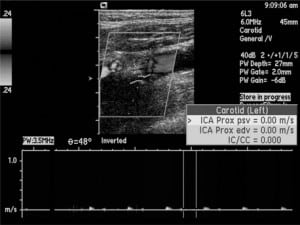
ANGIOGRAPHY
Catheter- based cerebral angiography or digital subtraction angiography (DSA) is the standard against which all non-invasive assessments of carotid luminal narrowing are commonly compared and remains the gold standard for the detection of many types of cerebrovascular disease. Angiography is a dynamic study and is a useful tool to visualize slow blood flow through a constricted vessel and delayed filling of capillary vessels.18 In addition, cerebral angiography can identify and allow the specialist to treat occluded or narrowed vascular segments and vascular malformations (Figures 16 and and 17).
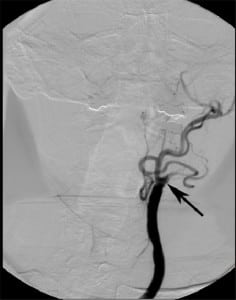
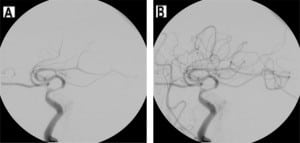
CONCLUSION
An accurate and practical understanding of imaging modalities is essential for the management of the acute stroke patient. Due to its wide spread availability and speed, unenhanced CT scan remains the initial study of choice for evaluating an acute stroke patient – it is used for inclusion criteria and to rule out hemorrhage. After bedside point of care testing is performed to establish the baseline creatinine, CT angiography can be obtained to give added information on stenotic and occluded blood vessels. If the CTA demonstrates a large or significant thrombus burden outside the three hour time window then intrarterial or mechanical thrombolysis may be an indicated treatment which may be performed by the skilled interventional neuroradiologist.
CT and MRI perfusion imaging can assist in identifying a stroke and potential areas of reversible and salvageable brain tissue in the ischemic penumbra.7 Identifying patients initially outside of the three hour window or in those which the time of onset is uncertain who have an area of potentially reversible ischemia may still benefit by intravenous, intra-arterial or mechanical reperfusion.
Traditional MRI remains a vital tool in the evaluation of the subacute stroke patient, due to its excellent soft tissue contrast. Specialized MRI techniques are also essential to exclude hemorrhage in patient’s whom SAH is suspected. MR with diffusion imaging can non-invasively detect ischemic changes and can be obtained within 10 minutes at some centers and dramatically alter care, so the clinical determination of ischemic stroke can be confirmed quickly. MRI with diffusion is quickly becoming the gold standard in acute stroke imaging but its use is limited because of the universal lack of access to this expensive equipment and technology, along with capable and experienced neuroradiologist to interpret the results.
MRA is helpful for detecting less common cause of ischemic stroke such as carotid and vertebral artery dissection, fibromuscular dysplasia, and venous thrombosis. It also aides in the detection of underlying aneurysms.
Sonography is currently an adjunct modality for stroke evaluation in certain settings. Angiography remains the gold standard against which all non-invasive assessments of carotid luminal narrowing and many types of cerebrovascular diseases are identified and treated. Catheter angiography is an important tool in the hands of skilled interventionalist and continues to be the modality to which new therapies in stroke care are constantly evolving and being compared.
While the ACR prefers MRI to CT for acute stroke it is not currently available and practical for most centers. The recommended MRI sequences are T1,T2, FLAIR, GRE (for Blood), DWI for acute ischemia, MRA, and PWI (for penumbra imaging). Most United States emergency departments do not have MR available for acute stroke .It is not uncommon in the ED to use DWI- MRI when the diagnosis of an acute stroke is unclear and it can help confirm the diagnosis.3
Footnotes
Dr. Dale Birenbaum would like acknowledge Dr. Bankcroft and Dr. Felsberg for their dedication, collegiality and time on this project.
Supervising Section Editor: Rick A. McPheeters, DO
Submission history: Submitted August 14, 2009; Revision received December 4, 2009; Accepted January 18, 2010
Reprints available through open access at http://escholarship.org/uc/uciem_westjem
Address for Correspondence: Dale S. Birenbaum, MD, FACEP, FAAEM, Clinical Assistant Professor, University of Central Florida School of Medicine, Florida State University College of Medicine, Program Director, Florida Hospital Emergency Medicine Residency Program, 601 E. Rollins, Orlando, FL 32803
Email: flerdoc@aol.com
Conflicts of Interest: By the WestJEM article submission agreement, all authors are required to disclose all affiliations, funding sources, and financial or management relationships that could be perceived as potential sources of bias. The authors disclosed none.
REFERENCES
1. American College of Radiology ACR; Reston, VA: 2009. ACR Appropriateness Criteria “Headache”www.acr.org/ac.
2. American College of Radiology ACR; Reston, VA: 2009. ACR Appropriateness Criteria “Cerebrovascular Disease” www.acr.org/ac.
3. Schwartz DT. Emergency Radiology:Case Studies. McGraw Hill; 2008. pp. 501–522.
4. Civetta, Kirby, Taylor, et al. 4th Edition. Lippencott: Williams and Wilkins; 2009. Critical Care; pp. 368–382.
5. Torres-Mozqueda F, He J, Yeh IB, et al. An acute ischemic stroke classification instrument that includes CT or MR angiography: The Boston Acute Stroke Imaging Scale. AJNR Am J Neuroradiol.2008;29:1111–7. [PubMed]
6. Wintermark M, Ko NU, Smith WS, et al. Vasospasm after subarachnoid hemorrhage: utility of perfusion CT and CT angiography on diagnosis and management. AJNR Am J Neuroradiol.2006;27(1):26–34. [PubMed]
7. Srinivasan A, Goyal M, et al. State of the art imaging of acute stroke. Radiographics. 2006;26:S75–S95. [PubMed]
8. Lin K, Rapalino O, Law M, et al. Accuracy of the Alberta Stroke Program Early CT Score during the first 3 hours of middle cerebral artery stroke: comparison of noncontrast CT, CT angiography source images, and CT perfusion. AJNR Am J Neuroradiol. 2008;29(5):931–6. [PubMed]
9. Konstas AA, Goldmakher GV, Lee TY, et al. Theoretic basis and technical implementations of CT perfusion in acute ischemic stroke, part 1: theoretic basis. AJNR Am J Neuroradiol.2009;30(4):662–8. [PubMed]
10. Gasparotti R, Grassi M, Mardighian D, et al. Perfusion CT in patients with acute ischemic stroke treated with intra-arterial thrombolysis: predictive value of infarct core size on clinical outcome.AJNR Am J Neuroradiol. 2009;30(4):722–7. [PubMed]
11. Nandigam RN, Viswanathan A, Delgado P, et al. MR imaging detection of cerebral microbleeds: effect of susceptibility-weighted imaging, section thickness, and field strength. AJNR Am J Neuroradiol. 2009;30(2):338–43. [PMC free article] [PubMed]
11. Wessels T, Wessels C, Ellsiepen A, et al. Contribution of diffusion-weighted imaging in determination of stroke etiology. AJNR Am J Neuroradiol. 2006;27(1):35–9. [PubMed]
12. Kranz PG, Eastwood JD. Does diffusion-weighted imaging represent the ischemic core? An evidence-based systematic review. AJNR Am J Neuroradiol. 2009;30(6):1206–12. [PubMed]
13. Latchaw RE, Alberts MJ, Lev MH, et al. Recommendations for imaging of acute ischemic stroke- a scientific statement from the American Heart Association. Stroke. 2009;40:3646–3678. [PubMed]
14. Kunz A, Hahn G, Mucha D, et al. Echo-enhanced transcranial color-coded duplex sonography in the diagnosis of cerebrovascular events: a validation study. AJNR Am J Neuroradiol.2006;27(10):2122–7. [PubMed]
15. Valaikiene J, Schuierer G, Ziemus B, et al. Transcranial color-coded duplex sonography for detection of distal internal carotid artery stenosis. AJNR Am J Neuroradiol. 2008;29(2):347–53.[PubMed]
16. Suwanwela NC, Phanthumchinda K, Suwanwela N. Transcranial doppler sonography and CT angiography in patients with atherothrombotic middle cerebral artery stroke. AJNR Am J Neuroradiol. 2002;23(8):1352–5. [PubMed]
17. Nakajima M, Kimura K, Ogata T, et al. Relationships between angiographic findings and National Institutes of Health stroke scale score in cases of hyperacute carotid ischemic stroke. AJNR Am J Neuroradiol. 2004;25(2):238–41. [PubMed]


